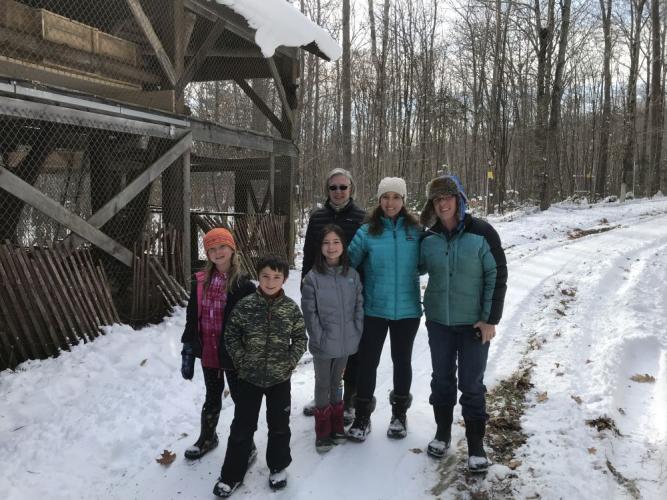Very poor year for natural foods causes a spike in road-killed mother bears leaving more cubs orphaned
- Tags:
- Wildlife

An orphan bear cub arrived at Thanksgiving after its mother was skilled by a car on Interstate 89 in New London.
Andy Deegan was filling birdfeeders and letting the dog out in the early morning gloom when he encountered what he thought might be “the biggest squirrel I’ve ever heard” scrambling up a large white pine just outside his New London home. It turned out to be a bear cub - an orphan. The missing mother was likely the same bear reported struck and killed by a car nearby on I-89 a week earlier. Authorities could not locate a cub that ran off after the accident.
The Deegan family – Andy and Carrie along with their two children, her mom, Sally Dean, her brother, Micah Dean and sister-in-law Becky and their three kids - were gathering for Thanksgiving Wednesday when they found themselves immersed in a 4-day project: capture and transport an orphan bear now visible from inside their living room. Simple, eh?
They contacted the NH Fish and Game dispatchers who recommended monitoring the cub over the weekend to see if a mom would retrieve it. Carrie tracked the cub in the snow to verify it had arrived alone without a mother. Andy contacted world-renowned bear expert Ben Kilham who operates a regional bear rescue and rehabilitation facility: The Kilham Bear Center in Lyme, NH. Kilham recommended they keep the cub nearby by feeding it and both Ben and Andy reached out to NHFG bear team leader, Andrew Timmins.
During the Thanksgiving holiday and in the midst of deer season, NHFG staff had been stretched thin, particularly as new reports of orphan bear cubs spiked. Timmins said: “There’s only a handful of us picking up bears statewide. We can’t be everywhere at once. Our effort includes staff from the USDA Wildlife Services, volunteers and select landowners. It’s not a department-wide initiative so we’ve had to get creative this year.”
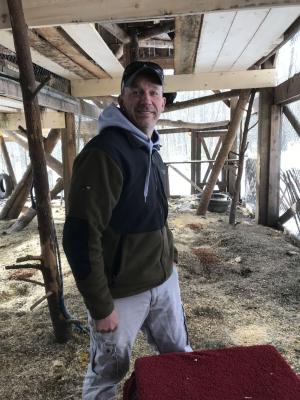
Guess Who’s Coming To Dinner?
Timmins delivered a cub-size cage trap from the NHFG Region 1 office in Lancaster to New London while on another errand and showed the Deegans how to bait and set the trap. He asked them to keep in touch and to transport the bear themselves to Ben Kilham if they proved successful over the holiday weekend.
Thanksgiving dawned bitter cold with a low of 4 and a high of 14 degrees with subzero wind-chill temperatures on Thursday. The orphan cub had barely moved from its pine tree perch. Shelled peanuts and black oil sunflowers lured the hungry cub down where it fed outside of the trap before clamoring back up. Carrie upped the ante’ by adding slices of Thanksgiving desserts: walnut honey cake and great grandma’s molasses cookies. Inside the living room they watched the cub visibly shivering. Their vigil included eating a turkey dinner “that had nearly gone cold” and in darkness because glare from the lights on the inside of the window made it hard to monitor the cub. “We ate in the dark while watching the bear sniff around outside the trap” added mom, Sally Dean. Far-flung relatives started friendly betting to guess what day and time the cub would be trapped. The family wanted a happy ending not just for the orphan cub, but also for the children who by now had named the cub “Boo-boo.”
“The low point came on Friday morning when the cub was gone – that was the worst” said Carrie. During the night, the cub descended, ate some bait and returned back up the tree. Sleep deprived, Andy saw the cub sniffing around the trap at 5:45 a.m. Friday morning but a nearby deer spooked and the cub ran off without triggering the trap door. Bait had frozen under the pivot pan and made it stick.
But the cub had chosen wisely: the right house, the right family. Determined to save the shivering cub, the Deegan clan set out to track the cub for a quarter mile though a swamp and forest, splitting up when tracks became indistinct. Carrie’s brother, Micah relocated a fresh track and found the cub high in a tall pine on a nearby property. Consulted by phone, Timmins suggested relocating the trap and trying again. He recommended using doughnuts, maple-flavored doughnuts doused with aromatic artificial vanilla flavoring - irresistible. “If you can at least keep it fed, that’d be great.” Receiving permission from the landowner, the Deegans re-baited the trap Friday afternoon and resolved to stay away until Saturday morning.
It worked! They found the cub inside the trap early Saturday. They covered it with a blue tarp, loaded it onto a plastic sled and pulled it for several hundred feet to the nearest roadside. They called Ben Kilham and made an appointment to deliver the cub from their garage to Lyme. As an afterthought, Andy decided to slip a bowl of water under the trap door. In an instant, the bear shot out and got loose inside the garage.
Are we having fun yet?
“Get back in the house kids!” Carrie yelled as the adults debated competing strategies to recapture the cub now climbing the garage walls, clinging to studs and hiding behind a tool chest. “Everyone put on thick gloves. We debated throwing a blanket over it but it would retreat into small spaces. He was fast and slippery. I tried to grab him by the scruff of his neck but he was strong and I couldn’t pull him off the wall” said Andy. Micah spied a net. He netted the cub and dragged it across the floor, somehow managing to get it into a dog crate they reinforced with zip ties at the corners, covered with a dog blanket and wrapped with ratchet straps. Houdini might have been proud. The cub eventually stopped thrashing and quieted, awaiting its fate.
It was a scenic ride up to rural Hanover Center Road where the pavement ends at Baker Hill and eventually to Dorchester Center Road where fields and pastures were crisscrossed by deer tracks in the snow. The full moon Friday night had illuminated forests devoid of fall wildlife foods. No red oak acorns, no remaining apples and no corn stubble. The fall famine had severely impacted the behavior of mice, squirrels, turkeys, deer and bears. The snow and bitter cold further complicated the search for food by local wildlife. Birdfeeders are a beacon to rodents. Predators will follow. Ornamental landscapes had attracted hungry deer. The red oak acorn bust is not an anomaly but part of a natural cycle following huge regional acorn crops that occurred in 2015 and 2016. Along with beechnuts, berries and apples, red oak acorns remain THE most important autumn wildlife food in central and southern NH. Following a fall famine, winter starvation becomes inevitable. Rodents had already plagued homeowners battling voracious mice and squirrels. The forest equivalent of a Thanksgiving Cornucopia – the horn of plenty – was much less so this autumn.

Overwhelmed with orphans
Ben Kilham emerged from his house and looked at the assembled Deegan clan. He explained: “We had no bears last year. Until two months ago, I had nine bears and now this one will total fifty-four. You do the math.” Forty-five new arrivals in two months to the rustic, private facility on several hundred, rural acres. “Most of the mothers were killed by cars on the Interstates. They are all out looking for food and there is none. The last time it was this bad was back in 2004.”
Kilham has worked with bears for 25 years. Ben, his wife, Deb and sister, Phoebe operate the not-for-profit “Kilham Bear Center.” Ben shared that it costs approximately $2500 per bear annually just for food alone to keep rescued orphans alive. A large barn with mesh fencing for walls serves as an indoor/outdoor enclosure with three levels of trees and platforms with boxes for hibernating. Human visitors are NOT allowed to keep the bears wild. A separate eight-acre outdoor enclosure contains healthier, fatter cubs that have already entered dens for the winter.
The same saga unfolded in other towns reporting abandoned bear cubs. More cubs arrived later the same week from Bridgewater, Hinsdale, Sandwich and Shelburne. Cubs arrived almost daily since September 26th when three were rescued in Moultonboro after their mother was hit by a car. Due to a lack of food, many sows’ milk had dried-up and mothers and cubs are entering winter malnourished this autumn. According to Andrew Timmins the orphans include nine cubs from motor vehicle strikes, four cubs from sows shot raiding goat or chicken pens, five cubs from sows killed by hunters and thirty cubs orphaned by unknown causes. Earlier in the season, “Mink” an infamous Hanover bear whose previous cubs had entered homes was relocated by NHFG and her four new cubs were brought to Kilham.
Some of the cubs remain awake eating apples, dried corn and dog kibble. Their percentage of body fat dictates hibernation. Most arrived in rough shape: underweight and malnourished. First year cubs typically weigh 50 pounds with 30% body fat before they den with their mothers. Pregnant females need a higher 50% body fat before denning. Yearling cubs who left sows last spring and are now in dens of their own weigh 75 pounds. Cubs have been coming to Kilham at 25 pounds or less. Underweight bears cannot den successfully. Bear birth rates will likely fall this winter due to poor nutrition. More single cubs will emerge from dens with their mothers next spring as opposed to twins and triplets. Timmins offered a sobering assessment: “Right now the only bears on the landscape are orphan cubs and they are starving to death. None of us want cubs to die on peoples’ lawns. We also don’t want to overwhelm the Kilhams but they won’t turn away cubs. We keep finding more. Others we won’t find. Some adults will succumb too. The bear population will reflect this autumn for years to come.”
As we approached the barn, Ben Kilham instructed us to keep our voices down. The kids were hoping to watch their cub released behind the curtain of chain link fence. The Deegan’s 8-year-old daughter approached Kilham with one important question: “Do the bears already have names?” Kilham turns with a question of his own: “What’s the name of this one?” “Boo-boo!” she answers.
Later Carrie Deegan told me her daughter was concerned there might be duplicate names. The orphan cubs are neither named nor tagged. Usually they receive a metal ear tag when they are released after it greens-up in springtime. This year, it was been difficult to keep up the new arrivals. Kilham estimated Boo-boo weighs twenty-five pounds.
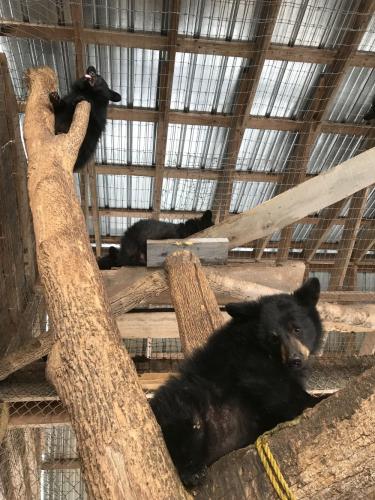
We carried the dog kennel inside the barn where bears were draped overhead. We passed an indoor enclosure containing a tiny fifteen pound cub recently delivered by a VT game warden. Its mother had been shot by a hunter earlier in autumn. Kilham said the cub was nearly dead when it arrived.
Kilham removed the blanket and cut the zip ties. The cub scrabbled its claws on the plastic kennel floor, startling a bear overhead that dropped down and scampered away. “Oh and they might also poop on you” Ben offered without even a hint of a smile. The cub sprinted from the open kennel to the far wall of the barn while peeing, obviously terrified.
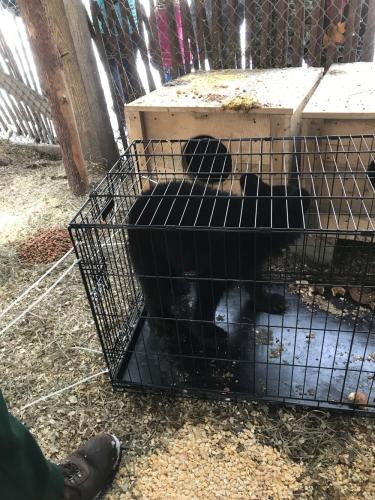
From overhead, dozens of bears shifted around and watched the new arrival scramble up to a platform. None of these cubs will be fitted with radio-collars or be tracked. The orphans are rescue bears, not study bears. Kilham has a local veterinarian on call to help care for any sick cubs. The simple goal for the cubs is to minimize human contact, help them gain weight and get them back into the forest as quickly as possible next spring. Kilham said “these cubs are wild and have already had 11 months experience with their natural mothers. They will go wild easily” when released next spring.
Phoebe Kilham arrived concerned about our entourage. Her goal was to get the people away from the enclosure. Most often a biologist or game warden drops off orphan cubs. Phoebe softened slightly as we gathered around with our questions. “If we could only get one week without new cubs coming in, the bears would all get to know each other and bond.” Later, Ben explained “bears have the ability to make friends and given time, they do. Almost any other mammal would have difficulty being around so many of its own kind. The number of incoming bears will slow at some point.”
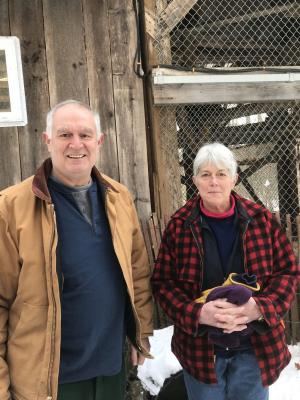
I asked Kilham for his most important goal. He focused on fundraising for construction of a new heated building with at least five indoor pens with an attached 10-acre outdoor fenced enclosure. “Right now, we are basically a hotel for these cubs” Many will remain awake to feed and gain weight until they can be released into suitable habitat by NHFG staff next spring. They don’t necessarily go back to where they were picked up. NHFG bear biologist, Andrew Timmins has earned Ben Kilham’s respect “Andy is dedicated. He likes bears a lot. Many other Fish and Game departments wouldn’t even bother.”
Timmins estimated the NH bear population was 5800 last spring. A total of 1,033 bears were killed during the autumn hunting season. He estimates another 150 to 200 bears died from a range of accidents or natural causes for a best guess at the current population around 4500. Timmins said the Kilham facility is unique by providing critical care for cubs in years when starvation or abandonment results in a spike in orphans. It’s obvious more cubs would die if wildlife agencies in NH and VT did not have some place to take orphans. “None of this would be possible without the ongoing efforts of the Kilham family: Ben, his wife Deb and his sister Phoebe. I can’t thank them enough for their help and assistance over many years.”
You can help care for orphan black bears by contacting and supporting the Kilham Bear Center at P.O. Box 37, Lyme, New Hampshire 03768. Visit their website at https://kilhambearcenter.org/
